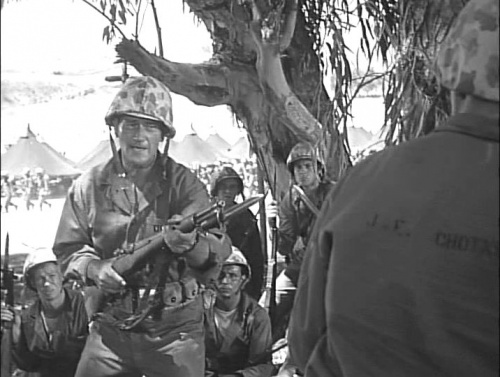
The intense 1953 film noir, The Hitch-Hiker, begins with news of a murderer at large.
His name is Emmett Myers (William Talman). He’s the rough-looking man who you might occasionally see standing by the side of the road, asking for a ride with his thumb outstretched. For me, it only takes one look at Myers’s unfriendly face and his shifty eyes to know that I would never slow down to give him a ride. However, The Hitch-Hiker takes place in a more innocent era, at a time when everyone wanted to be of help. Anyone who gives Emmett a ride ends up dead. He steals their cars and then drives across country, abandoning the car only when he learns that his previous murder has been discovered. Emmett has hitchhiked from Illinois to Southern California and he’s left a trail of dead bodies behind him.
Roy Collins (Edmond O’Brien) and Gilbert Bowen (Frank Lovejoy) don’t know who Emmett is. They’ve missed all of the reports about Emmett’s killing spree. They haven’t read the newspapers, all of which feature a picture of Emmett on the front page and a warning to never pick him up. Roy and Gilbert have been too busy getting ready for a long-planned fishing trip in Baja California. When they see Emmett hitchhiking in Mexico, they pull over and offer him a ride.
Unlike other movie hitchhikers, Emmett doesn’t waste any time before revealing who he is. As soon as he gets in the car, he pulls a gun and tells the two men that they’re going to drive him deeper into Baja California. He’s got a boat to catch and he says that all the two men have to do is follow orders. Of course, both Roy and Gilbert know better. They know that Emmett’s planning on killing them as soon as they arrive at their destination. In fact, if Emmett learns that the police are looking for the two men, he’ll kill them sooner. Roy and Gilbert not only have to keep Emmett from flying off the handle but they also have to keep him from discovering that both of them have been reported as being missing.
As the three men drive across California, Emmett continues to taunt his prisoners. Repeatedly, he points out that the only reason they’re in this situation is because of their loyalty to each other. As Emmett explains it, if the two men tried to run in opposite directions, Emmett would probably only be able to kill one of them. If the two men both attacked him, Emmett would again probably only have time to kill one before the survivor subdued him. Will Roy and Gilbert remains loyal to each other or will they finally embrace Emmett’s philosophy of every man for himself?
Oh, how you’ll hate Emmett Myers! As played by William Talman, Emmett is not just a criminal but a bully as well. The enjoyment that he gets out of taunting Roy and Gilbert will make your skin crawl. Emmett is hardly the type of witty or charming master criminal who often shows up in movies today. Instead, The Hitch-Hiker emphasizes that Emmett’s an idiot but, because he has the gun, he has the power. Edmond O’Brien and Frank Lovejoy are also well-cast as the two friends who are forced to choose between survival and loyalty.
The Hitch-Hiker was one of the few films to be directed by a woman in the 1950s. (It’s generally considered to be the only film noir to have been directed by a woman.) Ida Lupino was not only an actress but also the only female director in the old Hollywood system and she made several hard-hitting films, the majority of which dealt with the type of issues that mainstream Hollywood was still too scared to handle. With The Hitch-Hiker, Lupino emphasizes not only Emmett’s cruelty but also the bonds of friendship between Emmett’s two hostages. Visually, she makes the wide open desert appears as menacing and as dangerous as any shadowy city street. If urban noirs often suggested that threats could be hiding anywhere, The Hitch-Hiker takes the opposite approach. The threat is in the back seat of the car and there’s literally no place to hide.
The Hitch-Hiker is an intense film that holds up well today. Watch it below and never again make the mistake of helping out a stranger.







